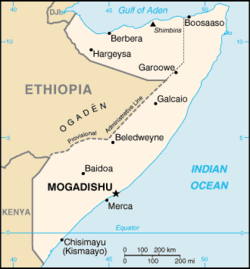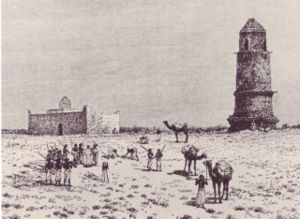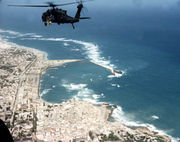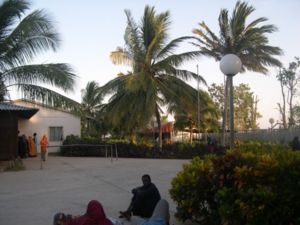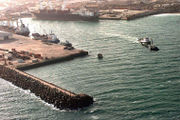Mogadishu
2007 Schools Wikipedia Selection. Related subjects: African Geography
Mogadishu ( Somali: Muqdisho, popularly Xamar; Arabic: مقديشو Maqadīshū; Italian: Mogadiscio), is the largest city in Somalia, and its nominal capital.
Mogadishu lies on the historically important Indian Ocean Benadir coast, and the city has served as an important regional port for centuries.
With the 1991 collapse of central governance in Somalia, Mogadishu has seen 15 years of fighting by rival militias. However, since June 2006, Mogadishu has seen unusual peace and stabiliy, thanks to the Islamic Courts Union - though the group is thought by many to be an arm of al-Quaida with plans to overthrow the Somali government. With no government and an unstable situation, estimates of the city's current population vary wildly, between 1.5 and 3 million.
Geography
Mogadishu is located at 2°4' North, 45°22' East (2.06667, 45.36667).
The Shebelle River (Webe Shabelle) rises in central Ethiopia and comes within 30 km of the Indian Ocean near Mogadishu before turning southwestward. Usually dry during February and March, the river provides water essential for the cultivation of sugarcane, cotton, and bananas.
Features of the city include the Hammawein Old Town, the Bakara Market, and the former resort of Gezira Beach.
Ibn Batuta spotted Mogadishu in his travels.
History
Medieval East African city-state
Trade connected Somalis in the Mogadishu area to other communities along the Indian coast as early as AD 800. Muslims from the Arabian Peninsula colonized Mogadishu circa 900. The relative affluence of these settlers made them powerful in Somalia. Inter-marriage with the locals produced economically beneficial relationships. Mogadishu was well suited to become a regional centre. While the majority of the Somali coast is arid, the area around Mogadishu is more suitable to agriculture and could support a larger population. It is also the northernmost site in East Africa with a good natural harbour.
The northernmost of the East African city-states, Mogadishu prospered with trade with the interior, which spread Islam throughout Somalia. Beginning about 1000, trade increased among the Swahili cities of coastal East Africa. This trade drove the Mogadishu economy by the early 1100s. The origin of the name "Mogadishu" is unclear; one version claims it as the Somali version of the Arabic language and/or Persian name "maqad shah" (imperial seat of the shah). The historic Mosque of Fakr ad-Din, built 1269, still stands.
Archaeological excavations have recovered many coins from China, Sri Lanka, and Annam. The majority of the Chinese coins date to the Song Dynasty, although the Ming Dynasty and Qing Dynasty "are also represented,"2 according to Richard R.K. Pankhurst. The trading Zanj city-states of the Swahili civilization imported Arabic pottery, Chinese porcelain, and Indian cloth. They exported wood, ivory, shells, slaves, and iron. Kilwa, which dominated the gold trade from the Great Zimbabwe, ultimately eclipsed Mogadishu, Lamu, Zanzibar, and other northern cities after the 1200s.
Trading across the Arabian Sea enabled major ports like Mogadishu to prosper during the later Middle Ages. Ross E. Dunn describes Mogadishu and other East African Muslim settlements as "a kind of medieval America, a fertile, well-watered land of economic opportunity and a place of salvation from drought, famine, overpopulation, and war at home."1
The abundance of food in Mogadishu around 1330 impressed visitor Ibn Battuta. He remarked that a single person "eats as much as a whole company of us would eat, as a matter of habit, and they are corpulent and fat in the extreme."3
European domination
Portugal controlled Mogadishu during the 1500s.
The sultan of Zanzibar occupied the city in 1871. Garesa Palace, built in the late 1800s for the local administrator of the sultan, now houses a museum and library.
In 1892, the sultan of Zanzibar leased the city to Italy. Italy purchased the city in 1905 and made Mogadiscio (Italian for Mogadishu) the capital of Italian Somaliland. The surrounding territory came under Italian control in 1936.
British forces operating from Kenya during World War II captured and occupied Mogadishu. The capital of Italian Somaliland fell to the British forces on February 26, 1941. The British continued to rule until Italy returned in 1952 to administer their former Somali protectorate. Education advanced with the 1954 establishment of Somalia National University. Somalia achieved independence in 1960 with Mogadishu as its capital.
Collapse of government and UN intervention
Rebel forces entered and took the city in 1990, forcing President Mohammed Siad Barre to resign and flee in January 1991 to Lagos, Nigeria. One faction proclaimed Mohammed Ali Mahdi president, another Mohammed Farah Aidid. The Somalia National University, which enrolled 4600 students before the war, closed as the educational system soon collapsed.
Intense battling between these rivals and other clan-based rebel factions damaged many parts of Mogadishu in 1991-1992 and led to tens of thousands of casualties as an intense drought-induced famine ravaged rural Somalia.
A contingent of United States Marines landed near Mogadishu on December 9, 1992 to spearhead United Nations peacekeeping forces. The United Nations sought to capture warlord Mohamed Farrah Aidid in 1993 to enable the establishment of a transitional government. Somalis loyal to him ambushed the peacekeepers and killed 24 Pakistanis.
On October 3, 1993, the United States Army Rangers and the army's Delta Force went on a mission to capture two of Aidid's warlords. Although the mission was successful, five American army UH-60 Black Hawk helicopters were shot down during the battle (two in the city [Durant's "Super 64" and Wolcot's "Super 61"] and 3 at a safe area), causing about 100 United States Army Rangers and Delta Force operators to be pinned down in the city, trying to rescue survivors and recover the dead. In this Battle of Mogadishu, the Somalis killed 18, one soldier three days later in a mortar strike and 1 Malaysian soldier and injured several dozen. Estimates put the number of Somali casualties at 500-1000 militia and civilians dead and 3000-4000 injured. The later nonfiction books Black Hawk Down: A Story of Modern War, In The Company Of Heroes, and motion picture Black Hawk Down dramatized the events of this battle.
With these casualties, United States President Bill Clinton withdrew American forces in 1994. Two factions in Mogadishu nevertheless reached a peace accord on January 16, 1994. Heavy fighting, however, intensified between numerous warlords and factions for control over the city after the March 3, 1995 withdrawal of the last international peacekeepers.
Mohamed Farrah Aidid declared himself president in June 1995 and by 1996 captured strategic neighborhoods in Mogadishu and some outlying territory. Rival militias renewed fighting in Mogadishu and Hoddur, Somalia in 1996. Aidid ultimately died in July 1996 from gunshot wounds suffered in a street battle.
Mogadishu today
Excessive Isbaros {checkpoints} and violence continued to rule Mogadishu and much of southern Somalia through the late 1990s and early 2000s, including the deaths of British Aid workers Dick and Enid Eyeington in 2003. Now clans have established territory for themselves and claim independence from the Republic of Somalia. All attempts to restore state order, by forming transitional governments while in exile, have failed.
On October 10, 2004, Somali MPs elected Abdullahi Yusuf, president of Puntland, to be the next president. Because of the chaotic situation in Mogadishu, the election was held in a sports centre in Nairobi, Kenya. Yusuf was elected transitional President by Somalia's transitional parliament. He won 189 of the 275 votes from Parliament. The session of Parliament was also held in Nairobi. His government is recognized by most western nations as the country's legitimate rulers, though his actual authority is extremely questionable. Right now the government refuses to enter Mogadishu due to security concerns and continuous fighting in the capital.
The worst clan warfare continues on the north side of the city; the southern neighborhoods, by contrast, experience significantly less violence and more prosperity. Some southern neighborhoods are rather safe and affluent enough to contain Somali-style mansions.
Currently Mogadishu is the only capital in the world where the UN does not have access for international humanitarian staff, due to insecurity, despite an estimated 250,000 internally displaced living in the city. The aid community is especially concerned over the delay in the polio and measles immunization campaigns.
Second Battle of Mogadishu
On 7 May 2006, fighting broke out between Islamist militias and an alliance of Somali warlords over control of Mogadishu. The three rival groups in Somalia are the transitional government, the Islamic Court Union (ICU), and the Alliance for the Restoration of Peace and Counter-Terrorism (ARPCT). Accroding to the UN report, the interim government received arms and up to 8,000 troops from Ethiopia, Yemen and Uganda and the ICU receives weapons from Eritrea, Djibouti, Iran, Syria, Libya, Egypt, Saudi Arabia and even Hezbollah. However accuracy of this report is disputed. The United States has in past admitted financing of the ARPCT.
Most of the combat is concentrated in the Sii-Sii (often written "CC" in English) district in northern Mogadishu with both the Islamist militias and the secular warlords fighting for control of Mogadishu. Though the Bush administration has neither confirmed nor denied support, American officials have anonymously confirmed that the U.S. is funding the ARPCT, due to concerns that the ICU has ties to al-Qaeda and is sheltering three al-Qaeda leaders indicted in the 1998 U.S. Embassy bombings in Kenya and Tanzania. It is believed that this al-Qaeda cell was also responsible for a 2002 suicide bombing of an Israeli-owned hotel in Kenya that killed fifteen people and a simultaneous failed attempt to shoot down an Israeli airliner over the country.
The fighting parties signed a cease-fire agreement on 14 May 2006 and as of 21 May, the Somali Cabinet suggested that Ugandan and Sudanese peacekeepers come to try and improve security.
The United Nations Security Council has rejected recommendations for tighter control of illegal weapons in Somalia and for targeted sanctions.
On 5 June 2006, the ICU militia seized Mogadishu, raising concerns in the U.S. due to suspected al-Qaeda links. While the ICU has consolidated control over Mogadishu, a transitional UN-supported government still exists in Baidoa; it is believed that the ICU may attempt to overthrow this government next.
Culture and economy
Mogadishu serves as a commercial and financial centre. The economy recovered somewhat from the worst civil unrest although the civil war still presents problems. The effective absence of government yields free trade without taxes or regulatory expenditures, making business relatively inexpensive. Businesses have hired armed militias to provide security against gunmen, leading to a gradual reduction in street violence.
Principal industries include food and beverage processing and textiles, especially cotton ginning. The main market offers a variety of goods from food to electronic gadgets.
Roads link the city with many Somali locales and with Kenya and Ethiopia. Private airlines service Mogadishu at various airports within and around the city; the intense fighting largely destroyed the old international airport, which has been recently reopened with flights, the first being a Daallo flight to Hargeisa. Mogadishu leads Somalia in port traffic and still serves as a major seaport. International traders actively benefit from its de facto duty-free status. However, piracy is widespread around Somalia's coastal areas, making it risky.
Mogadishu, along with some other parts of the former Somalia, is cited as an example of anarcho-capitalism. Despite (or perhaps because of) the lawlessness, Mogadishu leads East Africa in access to telecommunications and the Internet. A modern communications network has developed in the city, including local cellular telephone systems with international connections via satellite. The lack of taxes has led to modern communications prices that rank among the lowest in Africa. Numerous Internet cafes have produced an online population that rivals all of Ethiopia, Djibouti, or Eritrea. The city also has several radio stations, two television broadcasters, and an internet service provider.
